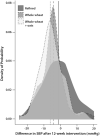Perspective: Application of N-of-1 Methods in Personalized Nutrition Research
- PMID: 33460438
- PMCID: PMC8166550
- DOI: 10.1093/advances/nmaa173
Perspective: Application of N-of-1 Methods in Personalized Nutrition Research
Abstract
Personalized and precision nutrition aim to examine and improve health on an individual level, and this requires reconsideration of traditional dietary interventions or behavioral study designs. The limited frequency of measurements in group-level human nutrition trials cannot be used to infer individual responses to interventions, while in behavioral studies, retrospective data collection does not provide an accurate measure of how everyday behaviors affect individual health. This review introduces the concept of N-of-1 study designs, which involve the repeated measurement of a health outcome or behavior on an individual level. Observational designs can be used to monitor a participant's usual health or behavior in a naturalistic setting, with repeated measurements conducted in real time using an Ecological Momentary Assessment. Interventional designs can introduce a dietary or behavioral intervention with predictors and outcomes of interest measured repeatedly either during or after 1 or more intervention and control periods. Due to their flexibility, N-of-1 designs can be applied to both short-term physiological studies and longer-term studies of eating behaviors. As a growing number of disease markers can be measured outside of the clinic, with self-reported data delivered via electronic devices, it is now easier than ever to generate large amounts of data on an individual level. Statistical techniques can be utilized to analyze changes in an individual or to aggregate data from sets of N-of-1 trials, enabling hypotheses to be tested on a small number of heterogeneous individuals. Although their designs necessitate extra methodological and statistical considerations, N-of-1 studies could be used to investigate complex research questions and to study underrepresented groups. This may help to reveal novel associations between participant characteristics and health outcomes, with repeated measures providing power and precision to accurately determine an individual's health status.
Keywords: Ecological Momentary Assessment; N-of-1; personalized nutrition; precision nutrition; review; self-report measures; study design.
© The Author(s) 2021. Published by Oxford University Press on behalf of the American Society for Nutrition.
Figures




Similar articles
-
The effectiveness of internet-based e-learning on clinician behavior and patient outcomes: a systematic review protocol.JBI Database System Rev Implement Rep. 2015 Jan;13(1):52-64. doi: 10.11124/jbisrir-2015-1919. JBI Database System Rev Implement Rep. 2015. PMID: 26447007
-
Novel study designs and modelling approaches in nutrition research: application of advanced statistical modelling approaches and N-of-1 study designs.Proc Nutr Soc. 2024 Dec 6:1-6. doi: 10.1017/S0029665124007602. Online ahead of print. Proc Nutr Soc. 2024. PMID: 39639645 Review.
-
The future of Cochrane Neonatal.Early Hum Dev. 2020 Nov;150:105191. doi: 10.1016/j.earlhumdev.2020.105191. Epub 2020 Sep 12. Early Hum Dev. 2020. PMID: 33036834
-
Ecologic Momentary Assessment: Perspectives on Applications and Opportunities in Research and Practice Regarding Nutrition Behaviors.J Nutr Educ Behav. 2016 Sep;48(8):568-577.e1. doi: 10.1016/j.jneb.2016.05.004. Epub 2016 Jun 7. J Nutr Educ Behav. 2016. PMID: 27287187
-
Single-Subject Studies in Translational Nutrition Research.Annu Rev Nutr. 2017 Aug 21;37:395-422. doi: 10.1146/annurev-nutr-071816-064717. Epub 2017 Jul 17. Annu Rev Nutr. 2017. PMID: 28715990 Free PMC article. Review.
Cited by
-
Precision nutrition: Maintaining scientific integrity while realizing market potential.Front Nutr. 2022 Sep 2;9:979665. doi: 10.3389/fnut.2022.979665. eCollection 2022. Front Nutr. 2022. PMID: 36118748 Free PMC article. Review.
-
Perspective: Appraisal of the Evidence Base to Update DRI Values-Lessons from the Past, Thoughts for the Future.Adv Nutr. 2022 Aug 1;13(4):975-981. doi: 10.1093/advances/nmac041. Adv Nutr. 2022. PMID: 35404437 Free PMC article.
-
Diet-gut microbiome interaction and its impact on host blood glucose homeostasis: a series of nutritional n-of-1 trials.EBioMedicine. 2025 Jan;111:105483. doi: 10.1016/j.ebiom.2024.105483. Epub 2024 Dec 7. EBioMedicine. 2025. PMID: 39647263 Free PMC article. Clinical Trial.
-
Nature of the evidence base and approaches to guide nutrition interventions for individuals: a position paper from the Academy of Nutrition Sciences.Br J Nutr. 2024 May 28;131(10):1754-1773. doi: 10.1017/S0007114524000291. Epub 2024 Feb 2. Br J Nutr. 2024. PMID: 38305040 Free PMC article.
-
Nutrition-Related N-of-1 Studies Warrant Further Research to Provide Evidence for Dietitians to Practice Personalized (Precision) Medical Nutrition Therapy: A Systematic Review.Nutrients. 2023 Apr 4;15(7):1756. doi: 10.3390/nu15071756. Nutrients. 2023. PMID: 37049595 Free PMC article.
References
-
- Hecksteden A, Kraushaar J, Scharhag-Rosenberger F, Theisen D, Senn S, Meyer T. Individual response to exercise training–a statistical perspective. J Appl Physiol. 2015;118:1450–9. - PubMed
-
- Tighe P, Duthie G, Vaughan N, Brittenden J, Simpson WG, Duthie S, Mutch W, Wahle K, Horgan G, Thies F. Effect of increased consumption of whole-grain foods on blood pressure and other cardiovascular risk markers in healthy middle-aged persons: a randomized controlled trial. Am J Clin Nutr. 2010;92:733–40. - PubMed
-
- McCormack JP, Holmes DT. Your results may vary: the imprecision of medical measurements. BMJ. 2020;368:m149. - PubMed
Publication types
MeSH terms
Grants and funding
LinkOut - more resources
Full Text Sources
Other Literature Sources
Research Materials

